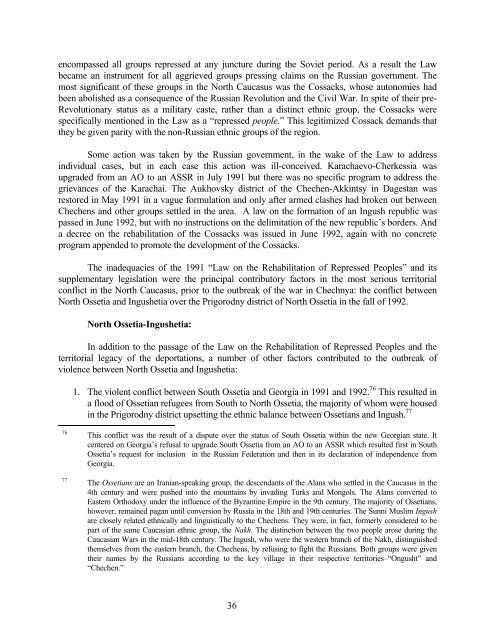RUSSIA'S TINDERBOX - Belfer Center for Science and International ...
RUSSIA'S TINDERBOX - Belfer Center for Science and International ...
RUSSIA'S TINDERBOX - Belfer Center for Science and International ...
Create successful ePaper yourself
Turn your PDF publications into a flip-book with our unique Google optimized e-Paper software.
encompassed all groups repressed at any juncture during the Soviet period. As a result the Law<br />
became an instrument <strong>for</strong> all aggrieved groups pressing claims on the Russian government. The<br />
most significant of these groups in the North Caucasus was the Cossacks, whose autonomies had<br />
been abolished as a consequence of the Russian Revolution <strong>and</strong> the Civil War. In spite of their pre-<br />
Revolutionary status as a military caste, rather than a distinct ethnic group, the Cossacks were<br />
specifically mentioned in the Law as a “repressed people.” This legitimized Cossack dem<strong>and</strong>s that<br />
they be given parity with the non-Russian ethnic groups of the region.<br />
Some action was taken by the Russian government, in the wake of the Law to address<br />
individual cases, but in each case this action was ill-conceived. Karachaevo-Cherkessia was<br />
upgraded from an AO to an ASSR in July 1991 but there was no specific program to address the<br />
grievances of the Karachai. The Aukhovsky district of the Chechen-Akkintsy in Dagestan was<br />
restored in May 1991 in a vague <strong>for</strong>mulation <strong>and</strong> only after armed clashes had broken out between<br />
Chechens <strong>and</strong> other groups settled in the area. A law on the <strong>for</strong>mation of an Ingush republic was<br />
passed in June 1992, but with no instructions on the delimitation of the new republic’s borders. And<br />
a decree on the rehabilitation of the Cossacks was issued in June 1992, again with no concrete<br />
program appended to promote the development of the Cossacks.<br />
The inadequacies of the 1991 “Law on the Rehabilitation of Repressed Peoples” <strong>and</strong> its<br />
supplementary legislation were the principal contributory factors in the most serious territorial<br />
conflict in the North Caucasus, prior to the outbreak of the war in Chechnya: the conflict between<br />
North Ossetia <strong>and</strong> Ingushetia over the Prigorodny district of North Ossetia in the fall of 1992.<br />
North Ossetia-Ingushetia:<br />
In addition to the passage of the Law on the Rehabilitation of Repressed Peoples <strong>and</strong> the<br />
territorial legacy of the deportations, a number of other factors contributed to the outbreak of<br />
violence between North Ossetia <strong>and</strong> Ingushetia:<br />
1. The violent conflict between South Ossetia <strong>and</strong> Georgia in 1991 <strong>and</strong> 1992. 76 This resulted in<br />
a flood of Ossetian refugees from South to North Ossetia, the majority of whom were housed<br />
in the Prigorodny district upsetting the ethnic balance between Ossetians <strong>and</strong> Ingush. 77<br />
76 This conflict was the result of a dispute over the status of South Ossetia within the new Georgian state. It<br />
centered on Georgia’s refusal to upgrade South Ossetia from an AO to an ASSR which resulted first in South<br />
Ossetia’s request <strong>for</strong> inclusion in the Russian Federation <strong>and</strong> then in its declaration of independence from<br />
Georgia.<br />
77 The Ossetians are an Iranian-speaking group, the descendants of the Alans who settled in the Caucasus in the<br />
4th century <strong>and</strong> were pushed into the mountains by invading Turks <strong>and</strong> Mongols. The Alans converted to<br />
Eastern Orthodoxy under the influence of the Byzantine Empire in the 9th century. The majority of Ossetians,<br />
however, remained pagan until conversion by Russia in the 18th <strong>and</strong> 19th centuries. The Sunni Muslim Ingush<br />
are closely related ethnically <strong>and</strong> linguistically to the Chechens. They were, in fact, <strong>for</strong>merly considered to be<br />
part of the same Caucasian ethnic group, the Nakh. The distinction between the two people arose during the<br />
Caucasian Wars in the mid-18th century. The Ingush, who were the western branch of the Nakh, distinguished<br />
themselves from the eastern branch, the Chechens, by refusing to fight the Russians. Both groups were given<br />
their names by the Russians according to the key village in their respective territories–“Ongusht” <strong>and</strong><br />
“Chechen.”<br />
36
















